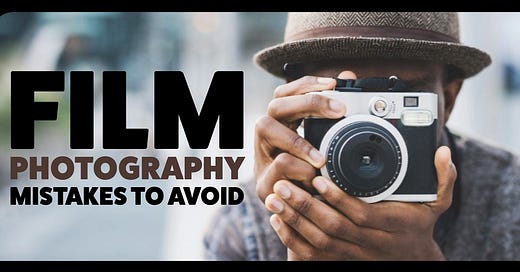5 Common Film Photography Mistakes to Avoid: A Beginner's Guide
Film photography has experienced a remarkable resurgence in recent years, captivating photographers with its unique aesthetic and tactile process.
This revival is driven by a desire for a more intentional and hands-on approach to image-making, as well as the distinctive look that only film can provide.
Despite the convenience of digital cameras, many photographers are drawn to the charm and character of analog photography.
The Unique Qualities of Film Photography
Before we discuss common mistakes, let's explore what makes film photography special:
Higher Dynamic Range: Film captures a wider range of tones between highlights and shadows, resulting in more nuanced images.
Organic Grain: Unlike digital noise, film grain adds a pleasing texture and character to photos that are difficult to replicate digitally.
Color Consistency: Film stocks offer unique and consistent color profiles that many photographers find more appealing than digital renditions.
Tangibility: There's a special joy in holding a physical negative or print, creating a more tactile connection to your work.
Slower, More Deliberate Process: Film encourages a thoughtful approach to photography, as each frame is precious and can't be instantly reviewed.
Now, let's explore the common pitfalls beginners should avoid when venturing into film photography.
1. Overvaluing High-End Equipment
Many newcomers believe that expensive cameras are necessary for quality film photography.
In reality, the photographer's skill and vision are far more important than the price tag of the equipment.
A film camera is essentially a light-sealed box that holds film.
Focus on developing your eye and technique rather than obsessing over gear.
Pro Tip: Invest in quality lenses rather than expensive camera bodies. A great lens on an affordable camera can produce amazing results.
Recommended Beginner Film Cameras:
Pentax K1000 with a 50mm prime lens
Minolta X-370 with a 50mm f/1.7 lens
Canon Sure Shot series for point-and-shoot options
These cameras offer a good balance of features, affordability, and reliability for beginners.
For more insights on choosing the right gear, check out my Budget Filmmaking Gear for Beginners.
2. Neglecting Proper Light Metering
Unlike digital cameras with automatic exposure modes, many film cameras require manual input.
Failing to meter light correctly is a common mistake that can lead to disappointing results.
Always take the time to meter your scene before shooting.
Recommended Film Stocks for Beginners:
Kodak Gold 200 (color)
Fujifilm Superia 400 (color)
Kodak Tri-X 400 (black and white)
Ilford HP5 Plus 400 (black and white)
These films offer good exposure latitude and are forgiving for beginners learning to meter properly.
Helpful Resource: Learn about how metering and rating film go hand in hand to improve your exposure accuracy.
Additionally, my Essential Camera Settings for Beginners guide can help you get started.
3. Overcomplicating the Process
Film photography can seem daunting at first, but it's often simpler than beginners expect.
Embrace the experimental nature of film and enjoy the tactile process.
Remember: Film photography is about the experience, risk, reward, and beauty of imperfection.
For more on overcoming initial fears, read my Overcome Fear of Street Photography article.
4. Ignoring Film Storage and Handling
Proper film storage and handling are key for maintaining image quality.
Store your film in a cool, dry place, and be mindful of expiration dates.
When loading and unloading film, do so in a subdued light to avoid accidental exposure.
Quick Tip: Keep unexposed film in the refrigerator to extend its shelf life.
For more tips on gear maintenance, see our Camera Gear Storage and Protection Tips.
5. Overlooking the Entire Image Creation Process
Many beginners focus solely on camera and film choice, expecting results similar to their inspirations.
But, film photography involves multiple stages that affect the final image, including development and scanning or printing processes.
Key Insight: Experiment with different labs or home development techniques to find the look you desire.
My Photography Studio Setup Guide can provide additional insights into creating a conducive environment for your film photography.
And That’s It
Avoid these common mistakes and you'll be well on your way to creating beautiful film photographs.
For more tips on getting started with film photography, check out my guide on Film Cameras for Beginners.
I hope that helps,
Hakan.



